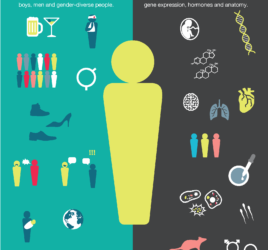
“Women with autism are much less empathic than other women”. I am not so sure…
Recently, I have noticed an increased interest in gender differences in both physical and psychiatric disorders. This is great news as such differences have been neglected far too long. In my own area of interest, autism spectrum disorders (ASD), research on females is scant and findings on female-specific difficulties have so far mostly yielded inconsistent results. According to official DSM-V criteria, people with ASD tend to have communication deficits, such as responding inappropriately in conversations, misreading nonverbal interactions, or having difficulty building friendships with peers. They may also be overly dependent on routines, highly sensitive to changes in their environment, or intensely focused on inappropriate items.
“These characteristics fall into a triad of impairment: social interaction, social communication and the presence of restricted and repetitive behaviours.”
In females however, we tend to see fewer and different repetitive and restricted behaviours than in males with this condition. Their communication has also been found to differ; they have been found to be better able to use appropriate gestures together with speech, and maintain a reciprocal conversation. Further, they experience different social interaction problems; they have been found to experience fewer problems at school and may struggle less with initiating friendships than males with ASD do, but find it hard to maintain these friendships. The above triad of impairments that defines autism, is thus different for females. Therefore, there is no clear picture of exactly what autism looks like in females. Recent studies [1-3] show that ASD is approximately five times less prevalent among females (1 in 189) than among males (1 in 42), though this difference may be overestimated due to diagnostic and screening differences .
“Why this lower rate of autism diagnosis in females?”
One explanation is that females with ASD may be protected against some of the impairments associated with this disorder; also referred to as the female protective effect (FPE), and in order for females to show such impairments in the first place they require a greater etiologic load than males. This means that a small to medium level of genetic disruption does not cause problems in females, but a large level does; explaining the tendency for females with a diagnosis of ASD to present with more severe symptoms than males.
This thought is supported on a behavioural level by the theory that two independent cognitive styles, empathising and systemising, exist, which are thought to be differentially pronounced in females and males. Females are believed to have a higher empathizing ability; the ability to accurately identify another person’s mental state and to respond to it with appropriate emotions of one’s own. Males, on the other hand, are thought to be better at systemising; the ability to analyse and construct systems whereby allowing the individual to discover regularities in this system’s ‘behaviour’ and consequently predict how it will behave in the future. People with ASD may show average to superior systemising together with diminished empathising; i.e. the extreme male cognitive style, which Baron-Cohen and colleagues referred to as a hypermasculinised brain [4]. Many studies have found that people with ASD report lower levels of empathy [5-12].
“Despite clear gender differences in empathy in the general population, such differences among people with an ASD have been neglected.”
However, the hypermasculinisation described above would lead the empathic ability of women with ASD to resemble that of men more closely than that of women without ASD.
My colleagues and I wanted to examine this and also find out how females with ASD differ from men with regard to self-reported empathy. We were particularly interested in determining whom these women resemble most closely: typically developed women, typically developed men, or men with an ASD. We searched for studies examining self-reported empathy in both women and men with and without ASD, and although we only found six studies the results were unequivocal. We were intrigued to find that women with ASD reported much lower levels of empathy than typically developed women and were therefore in this respect much more similar to men with ASD than to typically developed women. Gender differences, as they are consistently found in the general population, were not identified [13].
“But were the women included in the samples representative of women with ASD in general?”
We put quite a large question mark behind that. Females are being diagnosed with ASD (and other conditions) according to male-based criteria, which means that many of those females that have a diagnosis present with male-specific symptoms, including a hypermasculinisation of empathy. The female-specific autism traits constitute the female autism phenotype, which is likely quite different from the typical, male phenotype (see http://mindwise-groningen.nl/the-female-autism-phenotype-typical-versus-non-typical-asd-in-girls-and-women/). I assume this phenotype is detected by current diagnostic criteria much less frequently because such criteria have been derived from studies involving mostly males and are therefore likely to be male-specific. This female ASD phenotype may be particularly difficult to identify in females with average to above average cognitive level, as they are better able to camouflage their symptoms. It is likely that females who do not present such symptoms are not being identified at all, as the clinical presentation of ASD in females is not yet clear. What complicates this matter further, is the consistent finding that, in childhood, girls with comparable levels of autistic traits to boys tend to not receive a diagnosis of ASD unless they also present with cognitive impairment or behavioural problems [14].
“The above leads me to believe that females with a diagnosis of ASD are likely on the more severely affected end of the ASD continuum.”
Therefore, to answer the question in the title: “are women with autism really much less empathic than women without autism or is there something else going on?”, I have to answer that I cannot be sure but that I indeed think there is something else going on. The under-diagnosis of females with ASD due to the unknown female autism phenotype. And, we are going to find out so much more about the unknown in our next study!
References:
- Centers for Disease Control and Prevention. Prevalence of Autism Spectrum Disorder Among Children Aged 8 Years — Autism and Developmental Disabilities Monitoring Network, 11 Sites, United States, 2010.
- Honda H, Shimizu Y, Imai M, Nitto Y. Cumulative incidence of childhood autism: a total population study of better accuracy and precision. Dev Med Child Neur, 2005; 47: 10-18.
- Werling DM, Geschwind DH. Sex differences in autism spectrum disorders. Curr Opin Neurol, 2013; 26: 146-153.
- Baron-Cohen S. The extreme male brain theory of autism. Trends Cogn Sci (Regul Ed ), 2002; 6: 248-254.
- Baron-Cohen S, Knickmeyer RC, Belmonte MK. Sex differences in the brain: implications for explaining autism. 2005; 310: 819-823.
- Baron‐Cohen S. Autism: the empathizing–systemizing (E‐S) theory. Ann N Y Acad Sci, 2009; 1156: 68-80.
- Baron-Cohen S, Cassidy S, Auyeung B, Allison C, Achoukhi M, Robertson S, Pohl A, Lai MC. Attenuation of typical sex differences in 800 adults with autism vs. 3,900 controls. PloS one, 2014.
- Goldenfeld N, Baron-Cohen S, Wheelwright S. Empathizing and systemizing in males, females and autism. Clin Neur Psych, 2005; 2: 338-345.
- Sucksmith E, Allison C, Baron-Cohen S, Chakrabarti B, Hoekstra R. Empathy and emotion recognition in people with autism, first-degree relatives, and controls. Neuropsychologia, 2013; 51: 98-105.
- Wakabayashi A, Baron-Cohen S, Uchiyama T, Yoshida Y, Kuroda M, Wheelwright S. Empathizing and systemizing in adults with and without autism spectrum conditions: Cross-cultural stability. J Autism Dev Disord, 2007; 37: 1823-1832.
- Wheelwright S, Baron-Cohen S, Goldenfeld N, Delaney J, Fine D, Smith R et al, Weil L, Wakabayashi A. Predicting autism spectrum quotient (AQ) from the systemizing quotient-revised (SQ-R) and empathy quotient (EQ). Brain Res, 2006; 1079: 47-56.
- Hadjikhani N, Zürcher N, Rogier O, Hippolyte L, Lemonnier E, Ruest T et al, Ward N, Lassalle A, Gillberg N, Billstedt, E. Emotional contagion for pain is intact in autism spectrum disorders. Translational Psychiatry, 2014; 4: e343.
- Kok FM, Groen Y, Becke M, Fuermaier AB, Tucha O. Self-Reported Empathy in Adult Women with Autism Spectrum Disorders–A Systematic Mini Review. PLoS ONE, 2016; 11: e0151568.
- Dworzynski K, Ronald A, Bolton P, Happé F. How different are girls and boys above and below the diagnostic threshold for autism spectrum disorders? 2012; 51: 788-797.
NOTE: Image by Sharon Sinclair, licenced under CC BY 2.0.



